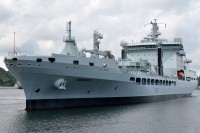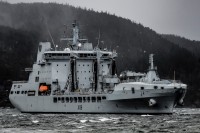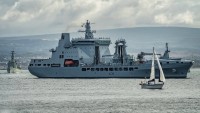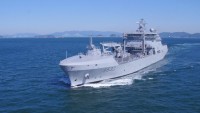Tide-class replenishment ship
Basic information
Ship measurements
Machine
- Combined diesel-electric or diesel
- 2 * 7,500 kW Wärtsilä main engines
- 2 * 3,170 kW Wärtsilä diesel generators
- 2 * 1,000 kW Wärtsilä bow thrusters
Personnel
Combat assets
- Tanks for diesel oil, aviation fuel (19,000 m³) and fresh water (1,400 m³)
- Lubrication oil stored in drums
- Stowage for up to eight 20 ft containers
- Kelvin Hughes Integrated Bridge System
- Servowatch IPMS System
- 3 * SharpEye radar
- 2 * Phalanx CIWS (fitted for, depending on deployment)
- 2 * DS30B Mk 1 30 mm guns (fitted for, depending on deployment)
- 1 * Wildcat or AgustaWestland Merlin
Aviation facilities
- Enclosed Merlin-capable hangar
- Large Chinook-capable flight deck
The Tide-class tanker (previously known as the Military Afloat Reach and Sustainability (MARS) project) is a group of four swift fleet tankers that commenced operations with the British Royal Fleet Auxiliary in 2017. These 37,000 t vessels supply fuel, provisions, potable water, munitions, and other resources to Royal Navy vessels globally. Norway ordered a comparable 26,000 t model featuring a 48-bed hospital and increased solid storage capacity, albeit with reduced liquid storage. It was delivered in November 2018 as HNoMS Maud, deviating from the original plan by two years. Although the two variants share similarities, their diverse capabilities make direct comparison challenging.
Both variations are derived from the AEGIR design by Britain's BMT Defence Services but were constructed by Daewoo in South Korea, undergoing final fittings in the UK and Norway, respectively. The UK initially ordered four ships in February 2012, budgeted at £452m for hull construction, which eventually escalated to £550m.
The Norwegian Navy procured HNoMS Maud in June 2013 for £140m. The order placed on February 22, 2012, for four tankers at Daewoo stood at £452m, with an additional £150m allocated for UK expenditure, totaling slightly over £600 million for all four vessels. The decision to build in South Korea stirred controversy in Britain as no British yards bid for the contract. Eventually, the new class revived names from the Cold War Tide-class oilers — Tidespring (A136), Tiderace (A137), Tidesurge (A138), and the new name Tideforce (A139).
The Tide class, measuring 200.9 m (659 ft 1 in) and weighing 39,000 t, stems from BMT Defence Services' AEGIR-26 design. Its inception traces back to a civilian tanker from Norway's Skipskonsulent. These ships boast double hulls to minimize oil loss due to outer hull damage, aligning with MARPOL regulations for civilian tankers (partially applicable to military tankers). This design not only enhances safety but also allows access to areas discouraged for their single-hulled predecessors.
Equipped with three replenishment at sea (RAS) stations for diesel oil, aviation fuel, fresh water, and a rig for astern replenishment, the Tide class facilitates diverse replenishment methods. The flight deck accommodates helicopter replenishment (vertical RAS) and can handle a Chinook landing. Propulsion relies on medium-speed diesel engines in a hybrid CODELOD setup for fuel efficiency across speed ranges.
Each ship can be armed with two 30 mm cannons and two Phalanx CIWS. Usually, heavy armaments are installed only during high-risk deployments, aligning with RFA vessels' standard policy. For instance, as of June 2021, RFA Tidespring is outfitted with fore and aft Phalanx CIWS fixtures and both 30 mm cannons during its global deployment with CSG21.
Operators
Royal Fleet Auxiliary
Construction for RFA Tidespring commenced on June 24, 2014. After sea trials and outfitting with military equipment, it was expected to be operational in the fourth quarter of 2016. However, delays persisted, attributed to electrical design and installation complications. Tidespring reached the UK in spring 2017 for weapon and communication system fitting. Acceptance trials followed, with the remaining sister ships set to enter service by the end of 2018.
Royal Norwegian Navy
HNoMS Maud, ordered in June 2013 to replace HNoMS Tyr and HNoMS Valkyrien, incorporated the AEGIR-18R design. Its construction faced technical setbacks, leading to a delayed commissioning in Norway in May 2019.
Ships5
- Comments
 en
en ru
ru uk
uk
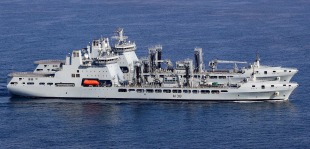



 Royal Norwegian Navy
Royal Norwegian Navy Royal Navy
Royal Navy Daewoo Shipbuilding & Marine Engineering Co., Ltd. (DSME)
Daewoo Shipbuilding & Marine Engineering Co., Ltd. (DSME)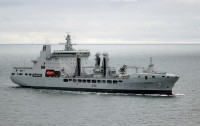
 Royal Fleet Auxiliary
Royal Fleet Auxiliary